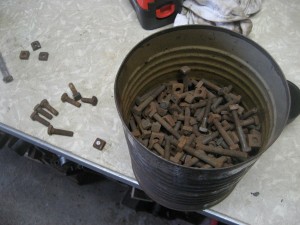Even today, on Via Rail you will often find the old (Rebuilt and well maintained) Bud fluted side equipment, mixed in with the LRC cars in the Eastern region.
The Canadian is all Bud equipped, but has on rare occasions had the odd LRC car in the consist. Often Via, on contract, “Dead Heads” some cars for the Western tourist train, the “Rocky Mountaineer”; East for rebuilding or repainting.
In it’s hay day, when the CPR still ran their large passenger network, their two main transcontinental trains, The Canadian, and The Dominion, they often mixed in lightweight cars, and old heavy weight ones with the Bud stainless steel stock.
As an added way to make your passenger trains more interesting, you can add in “Express Reefers”. These are not available as stock models from any manufacturers, except for the Aristo CN express box car. (Which is no more than a fancy paint job)
Express reefers and box cars differed from common freight cars, by being equipped with high speed trucks, and steam and signal lines besides the standard air lines.
If anyone wants a non expensive express reefer, with little effort; they just have to put B’mann, or LGB passenger trucks on a B’mann or LGB reefer. Repaint it and body mount Kadee couplers…and it looks rather good, even when included with 1:29 equipment, although taking it a step further, and getting rid of the truss rods would make it more believable.
Another car that appeared early on with the end of steam power, was the “Steam Generator car”. They were used when trains were long, and beyond the capacity of the steam generators in the Diesel Electric locomotives. They also allowed unequipped Diesels to work a passenger train.
One of my current never ending projects is to kitbash a pair of old Lionel plug door box cars into steam genny’s. Again, as with the express reefers; I’ll be using the B’man or LGB passenger trucks as simulated high speed trucks under them.
Try some of these ideas…you might even start doing more with you passenger trains, than running in circles. Passenger operations can be rather interesting, if you research how the real railroads did them. Dropping cars, and picking them up, as passenger demand dictated.
Express box cars were used for bulk mail, and magazine shipments, while express reefers were much in demand for fast delivery of fish and exotic produce. They were often dropped at towns along a passenger route. There were also “Silk Cars” catering to the silk trade.
Amtrak a few years ago were known for their special style “Material handling cars” in their trains…
I hope this long note is of some interest to some of you. Please let us know if you are looking into it, and post your ideas for “Passenger Train operations”. I’d be willing to try to get answers for any question on “Head End” equipment. I don’t claim to be an expert, and each railroad had it’s own way of equipping passenger trains over the years.
…Oh, yes…often to speed up operations, an express reefer or box car would be “Hung on” the tail end of a passenger train, and carried the “Marker Lights”. These could quickly be dropped at a city or town, and the local switcher would pick them up/and or put new ones on. This saved the road locomotives from having to sever the steam, air, and signal lines while switching cars out. It also prevented the steam lines from freezing up in deep cold weather.
Fred Mills
…Oh yes, when passenger trains were in their hay days, railroads often “Pooled” equipment, or co-operated in through cars, so just because you model one railroad, there is always a way to justify a “Foreign road” car, in your passenger train.YES…even if you model the B&O…!!



